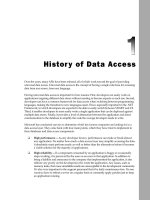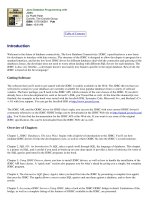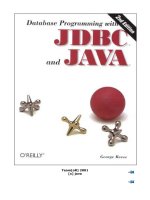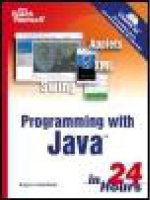Java Programming with Oracle ODBC - Preface
Bạn đang xem bản rút gọn của tài liệu. Xem và tải ngay bản đầy đủ của tài liệu tại đây (63.75 KB, 5 trang )
19.8 OCI Versus Thin Drivers
20. Troubleshooting
20.1 The "Gotchas"
20.2 Unsupported Features
20.3 Debugging
20.4 Net8 Tracing
20.5 Wait for the Cure
Colophon
Preface
Oracle is the write-once-run-anywhere database. Since the mid-1980s, Oracle has been available
on almost every operating system. With the release of Oracle RDBMS Version 6, you could
develop a database schema on your desktop knowing it could be implemented unchanged on
multiple large-scale platforms. With the release of Oracle7, stored procedures could be written
using PL/SQL, and once again, these could be ported to any supported operating system.
Oracle8 brought object orientation, and Oracle8i brought internal support for Java . These
releases represent 15-plus years of demonstrated commitment by Oracle Corporation to make
Oracle the write-once-run-anywhere database. But platform independence alone did not make
Oracle the dominant database in the marketplace. Other factors contributed as well:
Open-systems initiatives
Oracle grew up with Unix and therefore carries an open-systems attitude that has
fostered innovation and acute customer awareness.
Configurable resources
The Oracle RDBMS resources, such as filesystem and memory usage, are configurable
and manageable by the DBA. As a result, an Oracle database can be tuned for the task
at hand, whether that task is transaction processing, batch processing, or decision
support.
Leading technology
Oracle has consistently led the relational database industry technologically. From time to
time, competitors have temporarily leaped ahead of Oracle in a niche, but Oracle has
always retaken the lead.
You may have already guessed that I am an Oracle advocate. I have had 16 years of experience
with Oracle and its competitors, and this alone has taught me to respect the product. A more
telling story is how many developers who have worked with Oracle tell me all the things they miss
when they work with another product.
I got involved with Oracle accidentally. The company I was working for had acquired one of its
competitors, and I was sent to the West Coast to convert the reports from something called a
relational database to COBOL VSAM/ISAM programs on a minicomputer. The reason for the
conversion was the poor performance of the acquired company's reports. During the conversion, I
heard all the badmouthing going around at that time about relational technology. My thoughts at
the time were that, performance aside, relational technology greatly simplified decision-support
development. And, had the reports I was converting been done right, performance would not
have been an issue.
After that experience, I felt that eventually, relational database technology would dominate the
development market, so I decided to research the products available and pick the one that I
thought would emerge as the market leader. After several months of research, I decided on
Oracle, which at the time was just in Version 5. Since that time, I have been working with Oracle
and, from time to time, its competitors. Over the years, I have used COBOL, Pro*COBOL, C,
Windows SDK, Pro*C, OCI, C++, Smalltalk, Visual Basic, PowerBuilder, PL/SQL, and Java as
client development languages -- all to access an Oracle database. With my varied experience, I
still remember my first mistakes with Oracle -- performing that conversion was the very first.
I have learned more than anything else that the only reason a relational database performs poorly
is because we don't use it like a relational database. On that first project with Oracle, the previous
programmers were performing data processing the slow way: they opened cursors on different
tables and did fetches until they found a match between tables, essentially doing full table scans
and not using the database to perform the joins. There was really no reason to badmouth
relational technology back then, except for our own ignorance. Boy, I sure could have used a
good O'Reilly book on Oracle back when I did that conversion.
While Oracle was growing as the database product of choice, Sun Microsystems released Java in
the mid-1990s. Since that time, Java has gone from being considered an applet language, a
client-side language, a server-side language, an enterprise application language, and now, with
Oracle8i, an object-relational database language. That is so cool. Now we can leverage the
strength of relational technology and object orientation in our enterprise applications on both
client and server. But to leverage this technology to build enterprise applications, we need to
have a solid foundation. That is what this book is all about. Oracle Java DataBase Connectivity
(JDBC) is the foundation for all your Java/Oracle applications.
Why I Wrote This Book
I am a firm believer that good foundational knowledge is a must if you, as an application
developer, are going to write a robust application. Your knowledge of the fundamentals of the
technologies you're using makes or break not only any application you write, but your
programming career as well. I was extremely pleased to write a book about Oracle JDBC,
because it is the foundation for using Java with Oracle.
This is a book written by a programmer for programmers. I try to include enough detail to get the
novice up and running without boring the experienced programmer to death. My hope is that this
book will guide you through the process of making a connection and executing SQL statements
while maintaining database integrity and enabling you to use all the database technologies
offered by Oracle.
This Book's Intended Audience
This book covers a lot of material about Oracle's implementation of JDBC. It provides both the
beginner and the advanced Oracle or Java user with all the information needed to be successful.
However, a certain amount of basic knowledge about SQL, Java, and object orientation is a must.
I am often asked, "What's the best way for me to learn Oracle?" Wow! Now that's a loaded
question. To learn Oracle is a big task, because Oracle is a big product. But I always respond
with these suggestions:
• Go to and sign up on the Oracle
Technology Network (OTN, or Technet) as a member. It doesn't cost you anything to
become a member, and you get access to all of the Oracle documentation online. You
also get access to the discussion forums, where others like yourself post questions when
they're having problems. And you can download the most recent Java drivers and other
software for free.
• Better yet, sign up for a technology track or two. Technology tracks cost $200 each. For
your $200, you get four updates a year on a CD of all the software for a track. For $400,
you can get either the NT Servers or Linux Servers tracks along with the NT
Development Tools track and have a complete setup for learning Oracle.
• Do some serious studying. Read the Oracle Concepts Manual. Then read Oracle: The
Complete Reference, by George Koch and Kevin Loney (Osborne McGraw-Hill). Follow
that with the Oracle Developer's Guide. Then finish your beginner's work by reading
Oracle PL/SQL Programming by Steven Feuerstein with Bill Pribyl (O'Reilly). O'Reilly has
several other books on Oracle that you will find helpful. Check them out at
• If you have the funding, send yourself to all the Oracle developer classes and a couple of
DBA classes, too -- so you can keep your DBA honest. The DBA classes will also help
you when you try to create your own database in your "learning" environment.
Usually when I offer this advice, I get a response such as: "Gee, that sounds like a lot of work."
True, it is a lot of work, but I've been studying Oracle for 16 years and I still don't know all of it.
How else do you expect to make the big bucks?
As far as Java goes, reading Learning Java by Patrick Niemeyer and Jonathan Knudsen
(O'Reilly) is an excellent starting point. O'Reilly has an entire series of books on Java that take
each major area and cover it exhaustively -- for example, Database Programming with JDBC and
Java by George Reese (O'Reilly). George's book covers basics that are not database-specific
while pursuing a more abstract or advanced approach to examining the various ways you can
utilize programming models with JDBC. Check out all the Java series titles at
If you're into electronic documentation, you can download a copy of the JDBC Java specification
from Sun Microsystems at The standard JDBC API
Javadoc can be found in the doc directory of the JDK you install. If you want a complete JDBC
API Javadoc, you can download a copy of Oracle's JDBC Javadoc at the OTN web site.
Structure of This Book
This book attempts to be both a tutorial and a reference. It's divided into five parts and includes
20 chapters. The material builds upon itself as you go along. So if you skip ahead in any section,
be forewarned that you may have to backtrack. The book is packed with fully functional examples
that demonstrate each concept as it is discussed.
Part I
Introduction to JDBC introduces the JDBC API, defines the term client-server, and
uses that definition to identify four different clients that JDBC programmers may
encounter. These client definitions create a context for the material covered in Part II.
Part II
Chapters 2-7 cover topics related to establishing a connection. While most books cover
this material in a couple of pages, too many developers suffer with the nuances of
establishing a connection under the four different client types not to warrant a more in-
depth coverage of the material.
Part III
Chapters 8-13 cover topics related to the use of traditional relational SQL. They also
cover the use of large binary objects (LOBs) and batching.
Part IV
Chapters 14-16 cover topics related to the use of Oracle's object-relational SQL. You will
learn how to work with user-defined database types using JDBC.
Part V
Chapters 17-20 cover topics related to transaction management, data integrity, locking,
detection, and troubleshooting. While not strictly part of JDBC, these are essential topics
that every JDBC programmer should understand.
Conventions Used in This Book
The following typographical conventions are used in this book:
Italic
Used for filenames, directory names, table names, field names, and URLs. It is also used
for emphasis and for the first use of a technical term.
Constant width
Used for examples and to show the contents of files and the output of commands.
Constant width italic
Used in syntax descriptions to indicate user-defined items.
Constant width bold
Indicates user input in examples showing an interaction.
UPPERCASE
In syntax descriptions, usually indicates keywords.
lowercase
In syntax descriptions, usually indicates user-defined items such as variables.
[ ]
In syntax descriptions, square brackets enclose optional items.
{ }
In syntax descriptions, curly brackets enclose a set of items from which you must choose
only one.
|
In syntax descriptions, a vertical bar separates the items enclosed in curly or square
brackets, as in {TRUE | FALSE}.
...
In syntax descriptions, ellipses indicate repeating elements.
Indicates a tip, suggestion, or general note.
Indicates a warning or caution.
Software and Versions
This book covers Oracle8i, Release 2, Version 8.1.6, which is the first version of Oracle to
support JDBC Version 2.0. Accordingly, the examples used in the book were tested with JDK
Version 1.2.2 and J2EE Version 1.2. Don't be discouraged if you're still using JDK 1.1.x. Most of
the examples, except for some of the J2EE stuff, work fine with JDK 1.1.5+. Even some of the
features that are new to JDBC 2.0, such as prefetching and batching, are supported under JDK
1.1.5+ via an additional Oracle import. All the program examples are available online at
Oracle8i, Version 8.1.7, and Oracle9i both introduce new features that represent incremental
improvements to Oracle JDBC. We'll discuss the most important of these new features in
Chapter 20. Even though I used Oracle8i, Version 8.1.6 for all the examples in this book,
everything you read still applies to Oracle8i, Release 3, Version 8.1.7 and to Oracle9i.
Most of the filenames in my examples use the Windows path notation using backslashes instead
of forward slashes. I use this notation not out of preference for a particular operating system (my
preference is Unix), but because I feel most of you will be learning how to use Oracle JDBC on a
Win32 platform. So for you Unix/Linux programmers, forgive me for making you reach over the
Enter key.
Comments and Questions
Please address comments and questions concerning this book to the publisher:
O'Reilly & Associates, Inc.
1005 Gravenstein Highway North
Sebastopol, CA 95472
(800) 998-9938 (in the United States or Canada)
(707) 829-0515 (international/local)
(707) 829-0104 (fax)
There is a web page for this book, which lists errata, examples, or any additional information. You
can access this page at:
To comment or ask technical questions about this book, send email to:
For more information about books, conferences, Resource Centers, and the O'Reilly Network,
see the O'Reilly web site at:
Acknowledgments
A Native American medicine man once told me, "A man needs a woman to teach him how to
live." With this I could not agree more. That said, I never would have been in a position to write
this book had it not been for the profound way in which my wife Diane has taught me how to live.
With her love, honesty, and tireless support, no matter how wacky some of my adventures or
ideas have been, she has always been there as a friend, pointing out that the only limits to my
ability were the ones I imagined. As a writing teacher, her advice has been immensely valuable. I
am truly grateful to have her help and advice. For the last year, while I have been writing this
book, she has pretty much lived without me. Yet she has been my sounding board on many
issues related to the book, and it all must have sounded like I was speaking another language. I
can't express in words how intensely I love her, but having the time to write this book is good
indication of how much she loves me. Thank you Diane!
This book was only half as good as it is now when I first turned my chapters over to my editor
Jonathan Gennick. The other half came from Jonathan's feedback. You can't imagine how
humbling it is to write a chapter of a book, edit yourself several times, send it to your editor, and
then get it returned to you with so many edit marks that it looks like it's the first paper you wrote in
your freshman year of high school. Nonetheless, through the process of editing emerges a work
that is better, better because of the teamwork between writer and editor. Thank you Jonathan!









